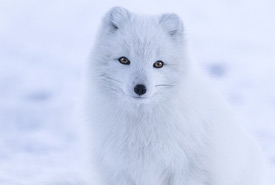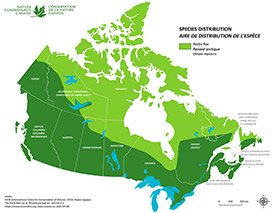
Arctic fox (Photo by Jonathen Pie)
Arctic fox
What does it look like?
Arctic fox is one of the smallest members of the canid, or dog, family in Canada. They can measure up to 115 centimetres in length and males can weigh up to nine kilograms — about the size of a large domestic cat. They have a white coat during snowy winter months and a darker coat that is more brown or bluish-grey in the summer.
Where are they found?
In Canada, the Arctic fox lives across the Arctic and northern boreal region, from the Yukon through to the island of Newfoundland, and from the northern tip of Ellesmere Island to the southern tip of James Bay. Their wide distribution throughout this harsh environment is attributed to its ability to adapt to freezing temperatures and its diverse diet.
What do they eat?
Their diets adapt depending on the season and availability of prey. In the winter, they feed primarily on small rodents, including lemmings, and use sea ice to trail polar bears, snacking on their leftovers from seal kills.
In the summer, the Arctic fox diet consists of birds, eggs, ground squirrels and berries. Arctic foxes in coastal regions scavenge dead marine mammals and fish.
What is NCC doing to protect habitat for this species?
NCC helped protect lands for the establishment of Vuntut National Park in the Yukon, where the Arctic fox can be found.





